The past year took me across the National Park System, from Cape Lookout National Seashore on the North Carolina coast to Glacier Bay National Park and Preserve in Alaska. The stories that spooled out from these trips into the National Park System told of advocacy and nurturing, of history and recreation, and even of controversy. Here's a look back.
April, Joshua Tree National Park
Joshua trees long dead stood once again, lending more depth to a landscape that, though looking parched and dusty in spots, still provides rich wildlife habitat.
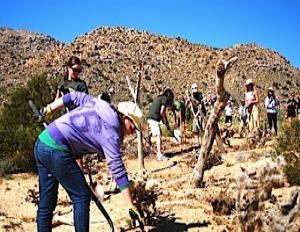
NPCA, Nature Valley and the Mojave Desert Land Trust worked on the landscape near Joshua Tree National Park. Kurt Repanshek photo.
Proof of that could be seen in a desert tortoise, the dirt on its shell evidence that it had recently emerged from its burrow, and a bit later in the form of a black-tailed jackrabbit that darted by at top speed.
Though this landscape falls just beyond the northern border of Joshua Tree National Park, it's only a matter of time before the nearly 960 acres becomes part of the park. Known as the Quail Mountain tract for a 5,814-foot mountain that already is part of the park, this parcel was acquired by the non-profit Mojave Desert Land Trust in fall 2010 and is waiting for the day Congress -- hopefully not too far off -- approves its attachment to the park.
Lack of a transfer date didn't seem to matter Saturday to the 50 or so volunteers who turned out for a land restoration party sponsored by the National Parks Conservation Association and Nature Valley, the granola bar and trail mix maker that is in the second year of what officials describe as a long-term effort to support the national parks.
June, Congaree National Park
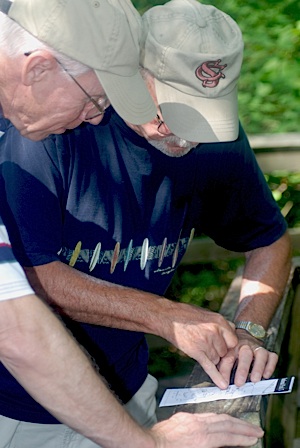
Even Jim and Bob need to consult maps, at times, to negotiate the parks, as they did in Congaree. Kurt Repanshek photo.
When was the last time you paused during a hike in a national park to simply stand there, take in the beauty, and listen to nature?
During a trip to Congaree National Park back in June I was able to do that with Bob Janiskee and Jim Burnett, and the three of us just stood quietly on the Boardwalk Loop and marveled in the sounds of that can be heard.
Silence truly is golden ... if you're able to filter out today's anthropogenic noise and listen to nature.
Click here to listen to the sounds of nature.
June, Cape Lookout National Seashore
Pushing us northward with every wave, the long-shore current raking Cape Lookout National Seashore is providing a great workout for our legs, arms, and stamina.
Everyone talks about the dangers of rip currents, but this wave machine with its stiff, knee-buckling current is relentless in testing not just our muscles, but our commonsense.
In the end, self-preservation won out and we exited the surf. But the cooling douse in the Atlantic near the end of a long day on the seashore was well worth it.
With sunset coming, and the sea oats covering the dunes stirred by the sea breeze, Cape Lookout was giving us the quintessential natural seashore experience, one devoid of over-development, asphalt, and commercialism. Running 56 miles along the lower leg of North Carolina's Outer Banks, this younger, and rougher, version of its older neighbor, Cape Hatteras National Seashore, is not for everyone.
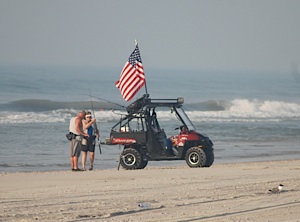
The beaches of Cape Lookout don't draw crowds. Kurt Repanshek photo.
No bridges tie Cape Lookout's three islands (North Core Banks, South Core Banks, and Shackleford Banks) to the mainland, no paved roads are stitched through the islands, and there are no Mini-Marts to dash out to for that item you forgot to pack. What this seashore does offer is a helping or two of the wild.
There are horses running wild on Shackleford Banks, white egrets roosting in trees gnarled and twisted not by high winds or heavy snows but by salty spray, and mile-after-mile-after-mile of beaches to comb.
June, Cape Hatteras National Seashore
Cape Hatteras National Seashore is one of the jewels not only of the Atlantic Seaboard, but also of the National Park System. Its wide, sparkling beaches are popular with visitors of all kinds -- humans, birds, and reptiles included -- and that creates problems at times when some of the wildlife are protected by the Endangered Species Act.
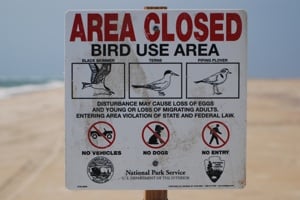
Closure signs irritated some beachgoers at Cape Hatteras. Kurt Repanshek photo.
In a two-part series, the Traveler looks at the differing viewpoints, the resulting friction, and the tough spot the National Park Service has found itself in in trying to manage the seashore for both humans and wildlife.
To help gain an understanding of how the conflict arose, in part one we lay out the landscape, both geologically and as wildlife habitat. In part two we examine the various viewpoints at play.
July, Petersburg National Battlefield
For months, beginning in mid-1864 and continuing on into the following Spring, Union troops tried again and again and again to throttle the Confederacy once and for all and end America's Civil War. From lines established near Petersburg, Virginia, and with supplies assured via a massive depot near today's Hopewell, Gen. Ulysses S. Grant embarked on a nearly 10-month siege on Petersburg with the end goal of breaking through to Richmond, the Confederate capital.
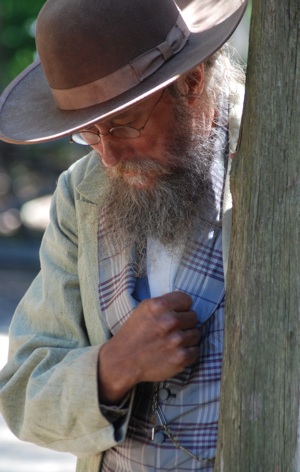
John Neely portrayed Civil War inventor R.O. Davidson for a re-enactment. Kurt Repanshek photo.
It was a demoralizing time for the Confederate troops, who by February 1865 were outnumbered nearly 2-1. If nothing else, Roderick Davidson stirred the hopes of at least some of the Confederate troops defending Richmond with his Artis Avis, a flying machine he believed could save the South.
"I was very anxious to see that man stampede the Yankee army," noted one soldier after Mr. Davidson roamed the Rebel lines at Petersburg seeking donations to enable his "bird" to take flight.
July, Cold Harbor Battlefield
Picturesque stands of trees, rolling fields, and quiet hide the violence that swept across the Cold Harbor battlefield in early June 1864 as Union troops commanded by General Ulysses S. Grant met a staggering defeat in one of the bloodiest encounters of the war.
Part of Richmond National Battlefield Park, a sprawling complex of Civil War sites that surround Virginia's capital, Cold Harbor proved to be a killing field on June 3, 1864, as Confederate troops mowed down upwards of 7,000 Union soldiers in less than an hour.
Gen. Grant had thought that if he could break through the Confederate lines here, it'd be short work to continue on to Richmond and force an end to the Civil War. Instead, the Union troops met disaster in a series of battles that stretched from late May into mid-June, with the worst outcome on June 3.
August, Glacier Bay National Park
I wasn't really sure what to expect from Glacier Bay National Park, outside of glaciers, of course. But it didn't take long to realize this Alaskan park is a birder's paradise. From the "poor man's puffin" to dwindling numbers of Kittlitz's murrelets, I was rewriting my birding success. And not in days, but in minutes.
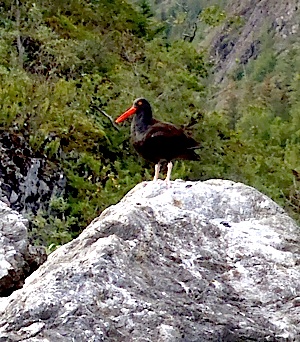
Glacier Bay is a birder's dream. Kurt Repanshek photo.
"Did you see all the young Glaucous-winged gull (Larus glaucescens) chicks?" park Ranger Linda Lieberman asked as we sat on the day-cruise ship Baranof Wind just off South Marble Island. "For those of you who want to see Common Murre (Uria aalge), the light is shining on them over here."
Not only were there Glacous-winged gulls and Common Murre -- an upright standing auk that, with its snow-white chest and belly, resembles a penquin -- but also Horned Puffins (Fratercula corniculata), Tufted Puffins (Fratercula cirrhata), Marbled murrelets (Brachyramphus marmoratus), an occasional Kittlitz's murrelet (Brachyramphus brevirostris), and Black-legged Kittiwakes (Rissa tridactyla).
And it wasn't even 10 a.m. yet.
September, Yellowstone National Park
Thigh-deep in the strong, bracing currents of the Bechler River was not exactly what I expected when I set out to explore Yellowstone National Park's Cascade Corner. But at least it was mid-September, and not mid-July, when the torrent surely would have been colder, deeper, and stronger.

The Bechler Region of Yellowstone is a joy to behold. Colonnade Falls, Kurt Repanshek photo.
If not for Stanley, a seasonal park ranger heading out of the Bechler region after days of backcountry maintenance revolving around the unenviable chore of relocating, if necessary, pit toilets, Bob and I might have been waist-deep.
Stanley, who crossed the river from the dry position atop his steed, had told us to cross not where the horse ford obviously was, but just downstream on the other side of a spring pouring into the river.
"It's shallower," he told us.
But not much.
As the above stories show, the National Park System is awash with incredible experiences, vistas, and history. They also, though, can generate controversy, sometimes on-going.
Here at the Traveler we encourage you to explore the park system at every chance, and educate yourself on the issues at hand. Study the various points of view and come to understand their roots. The parks need more advocates. Become one.


 Support Essential Coverage of Essential Places
Support Essential Coverage of Essential Places






